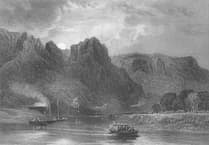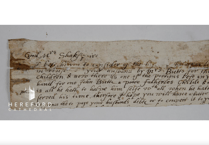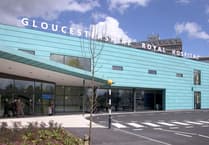The fields between Bromsash and Weston Under Penyard are now either greening with the next crop in their rotation, or dotted with sheep and lambs. A peaceful rural scene, and it is hard to imagine that some of these fields once were the site of the heavy industry of their day, and others rang with the clash of weapons.
The name Ariconium is now used for the group of churches in the area, but was originally the name of a Roman settlement at Bromsash, which was probably already a local tribal centre when the Romans developed it. The attraction was the ready supply of iron ore in the Forest of Dean. Ore was smelted and turned into the iron goods for which the Roman army was a ready customer. The then far more extensive woodland of southern England would have been used to make the charcoal needed for the process.
This work continued until the late 4th century, and once the Romans had finally left the demand for iron fell – as we would say, the bottom fell out of the market. This site of early industry still yields evidence, however, as anyone walking the fields in the area will know; lumps of iron “smelt” can be picked up very readily, and metal detectorists have found coins.
With the Romans gone, Britain went into the period we used to call “the Dark Ages”. The area around Bromsash, by now known as Archenfield, was at first controlled by the British / Welsh, but as Anglo-Saxon influence spread, the Kingdom of Mercia became the dominant power in this area, until Alfred the Great unified the land not controlled by the Danes. Alfred’s daughter Æthelflæd was ruling the sub-kingdom of Mercia when in either 914 or 917 a group of Viking mercenaries came on a raid. Setting out from Brittany, they sailed up the Severn estuary and set about pillaging the land and taking hostages. One of these was “Cyfeiliog, the bishop of Archenfield” (this is what the writers of the Anglo-Saxon Chronicle call him, he was actually Bishop of Llandaff), subsequently ransomed by the King (Æthelflæd’s brother Edward) for the huge sum of forty pounds.
The raiders were cornered in Archenfield, and many were killed, including the two leaders, “jarls” (from which we get the word earl) Hroald and Ohtor. The survivors, we are told, were driven into an enclosure and besieged until they surrendered and gave hostages, agreeing to depart from the King’s dominions.
The Tithe Map of Weston Under Penyard has both a Kill Dane Field and a Kill Dane Orchard, north of the lane from Weston to Bromsash, mute witness to a bloodshed over a thousand years before it was drawn up. We are looking forward to hearing more about the history of this area in October, when Professor Keith Ray comes to talk to us about “After Ariconium - the centuries of the Kingdom of Ergyng in the Wye Valley”.
Linton & District History Society meets, April 5th, 7 for 7:30 p.m. at Linton Village Hall, admission free for this evening. After a brief AGM, we are holding a book sale, and members and guests are invited to bring along objects to interest and intrigue.





Comments
This article has no comments yet. Be the first to leave a comment.